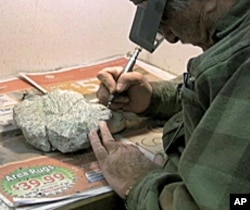Colorado has a long history of remarkable fossil finds. In the last few months alone, scientists have made exciting new discoveries, including the footprints of a running baby apatosaur.
Last year, a construction crew using heavy machinery to expand a local reservoir discovered the bones of Ice Age animals dating back 50,000 to 150,000 years. The muddy area near Colorado’s Snowmass ski resort had once been an ancient mountain lake.
Mammoth find
"They saw some ribs pop up over the big blade of the D-6 bulldozer. They knew right away that they had something different. It didn’t look like a cow but they didn’t know what it was. They picked it up and took it home and on the internet that night, they looked up what a mammoth looked like. And the next day they called us," said Ian Miller, curator of Paleontology at the Denver Museum of Nature and Science. "We have mammoths and mastodons, a giant ground sloth, Ice Age bison, deer, beavers, and a tiger salamander."
Museum researchers are now hard at work cleaning and examining the bones. While the big machines did crack some of the bones, Miller isn't upset.
"You’ve got to dig to find the fossils, and if you don’t go out and dig, you’re not going to go out and find anything," he said.
Once key concentrations of bones had been identified, the construction crew shifted to other areas, while researchers used shovels, hand picks, and sometimes their fingers to clear mud and peat away from the Ice Age bones.
Excitement ran high for paleontologists like Greg McDonald. "I’m hoping there’s some more sloth bones," he said, "because given the preservation, I think we’ve got the possibility of retrieving DNA from it."
By the time winter snows had shut down work in mid-November, scientists had retrieved more than 600 bones. In addition to recovering bones quickly and safely, the museum made sure the excavation did not slow down the reservoir construction project.
"We really worked hard to work closely with that contractor and keep them on schedule," said Miller, "but still get the treasures of Colorado out of these sites and into the museum."
State of discovery
Efforts like these have paid off many times in the past, so the Denver Science Museum now boasts some of the world’s finest fossils. They include Ice Age animals and Colorado’s official state dinosaur, the stegosaurus. One giant exhibit room is just large enough to hold the complete skeleton of one of the largest animals that ever walked on earth - the long-necked, long-tailed Diploducus, from the plant-eating sauropod family of dinosaurs. It’s fitting to have one at this museum, because in 1877, a fossil hunter found the world’s first sauropod bones in Colorado.
Since then, the discoveries haven't stopped. One of the newest on display at a small museum in the town of Morrison is a waist-high hunk of sandstone showing indentations from over 150 million years ago. They’re the coffee-mug sized tracks of a baby Apatosaur, another sauropod. These giants have usually been depicted as lumbering and clumsy. But the fossilized tracks indicate that the baby was balanced on its back legs, running.
Sometimes the finds are made by experts searching for fossil treasures. But many - like the Ice Age find - happen by accident, and often with the help of heavy machines.
In 1938, construction crews slicing through hills to build a highway exposed rock slabs covered with dinosaur tracks. Those finds led to the creation of the Dinosaur Ridge Museum. Just last year the museum’s tour bus driver decided to do a little fossil-hunting himself and found a site criss-crossed with ancient crocodile tracks.
"It’s one of the best crocodile sites in the world," says Joe Temple, director of the museum's Visitor Center."That bus driver has his name on an article in a scientific publication, and he’s training to become a school teacher, and he’ll remember that forever."
Temple says that anyone can be a fossil hunter. "You just need to have a set of fresh eyes and know a little bit about what you’re looking for," he said.
As for that mammoth find up in Snowmass, Miller says paleontologists will spend the rest of the winter in the museum’s science labs, cleaning and preserving the bones. But once the snow melts, probably in May, they’ll be back at the site, hoping to uncover more relics of Colorado’s ancient past.
















